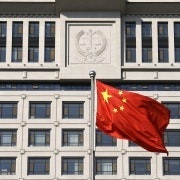China's gasping leap forward
Framed by the sight of thousands of pigs — whose deaths still remain unexplained — being fished out of the Huangpu River in Shanghai and weeks of above hazardous levels of air quality in Beijing, the carefully staged once-in-decade leadership transition was completed last week.
Xi Jinping was confirmed by the National People’s Congress as President and Li Keqiang as Premier. A new economic team was appointed, except that the rules were bent to keep the People’s Bank Governor on beyond his official mandatory retirement age of 65. The new team suggests that economic reform will be taken up again and that a major focus of reform policy will be to start to move towards more efficient allocation of capital through reform of the domestic financial system and capital account opening.
The new team takes over as further signs of economic strength emerge. These will be as welcomed by the new leadership as the first signs of spring are by the people of Beijing.
HSBC’s Flash PMI (Purchasing Managers’ Index) for March was 51.7, up on 50.4 in February and just below the two-year high of 52.3 in January. Anything over 50 means expansion is occurring. Both the January and February PMI’s would have been affected by the Spring Festival, with higher production in January to complete orders before the holidays then lower output growth in February because of the holiday shut down. So March is the first unaffected indicator for the year and it confirms strong growth in manufacturing.
Industrial output expanded 10 per cent over the two months of January and February compared to the same period last year, slightly down on December’s growth rate of 10.3 per cent. Retail sales rose 12.3 per cent over the same period, which was also slightly weaker than in December where retail sales rose 15.3 per cent. Inflation has also picked up from 2 per cent in January to 3.2 per cent in February, though Spring Festival buying of foodstuffs contributed to the higher rate.
Notwithstanding continuing weakness in the world economy, China’s manufactured exports grew particularly strongly in January and February, averaging around a 23 per cent rate of increase over the same period last year. Imports were also up sharply but not by as much as exports so the trade surplus has continued to rise.
Investment in fixed assets was up 21.2 per cent in the first two months of 2013, slightly above forecasts. Manufacturing investment rose 17 per cent, while infrastructure investment, where the role of state-backed finance is particularly powerful, increased 23 per cent.
This week China’s major state-owned banks will release their 2012 profit results and there are strong expectations that the economy’s gathering momentum will be reflected in higher profits. Non-performing loans are also expected to be negligible. China Construction Bank reported last Sunday a 14 per cent increase in net profit compared with 2011.
Adding to the positive atmosphere this spring, the OECD has just published a fairly bullish report on the Chinese economy forecasting growth in the order of the mid 8 per cent range for this year which it believes, with the right policy mix, will be sustained for several years. It has reaffirmed existing forecasts that the Chinese economy will overtake the US in 2016 to become the world’s biggest when measured in Purchasing Power Parity terms (that is, adjusted for price differences).
While these reports, as with the IMF’s country reports, have a lot of input into them from the subject country — China, the exhaustive rounds of reviews and committee discussions leads to a reasonably high degree of objectivity.
The OECD did point to a number of major policy challenges, which the new leadership will need to address if China is to stay on course for successive annual growth rates in the order of 8 per cent plus. In particular, the financial sector poses a number of risks to future growth and at the same time is increasingly ill-matched to support a more developed economy.
The OECD also highlighted the fact that China lagged behind countries at similar levels of development with an urbanization rate of just 53 per cent. This suggests that China’s investment-led growth strategy still has some way to run.
Sustained growth at the levels the OECD is forecasting will assist the new leadership team to tackle the many problems that continue to beset the Chinese economy, not least an anachronistic financial sector and the informal financial and debt markets that have emerged in response. Reform is easier with growth.
Growth, however, will not help the government with another major challenge that must be tackled urgently. It needs to re-build the trust of the educated, urban middle class, that it is capable of honestly and fairly regulating food and environmental standards. Unexplained pigs in the Huangpu River and dangerous air in Beijing have caught people’s attention during the National Peoples’ Congress, not the staged political theatre of the event itself.













